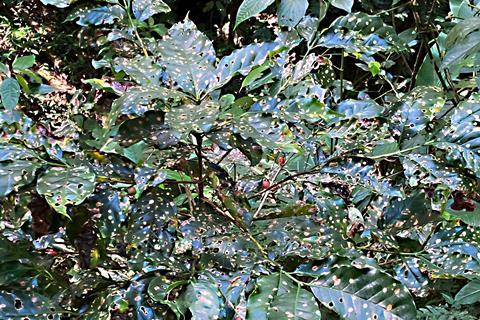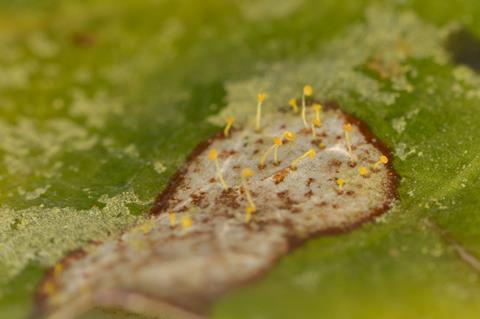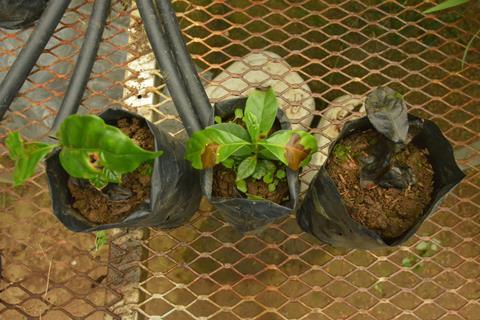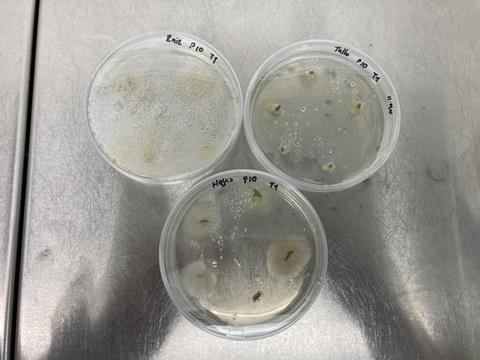Fungi found living within the tissue of plants from old growth forests in Costa Rica can colonize coffee seedlings and protect them from disease, a new study has revealed.
These endophytes can also improve the growth of the coffee plant, a team from Bowie State University in Maryland and University of Costa Rica has found.

Their findings are in a paper, ’The endophytobiome of wild Rubiaceae as a source of antagonistic fungi against the American Leaf Spot of coffee (Mycena citricolor)’, accepted by the Journal for Applied MIcrobiology, an Applied Microbiology International publication.
In the past decade, coffee plantations have been affected more than ever before by diseases that have been exacerbated by climate change, says corresponding author Dr Priscila Chaverri.
“Coffee is mostly planted in developing or underdeveloped countries. The increased damages caused by diseases, pests, and climate change have forced many poor or small farm holders, especially in Central America, to abandon coffee production. As a consequence, this has added another factor in the increasing poverty and illegal immigration into the USA,” she says.
Resilience of coffee
“As part of research being done in my lab, I would like to contribute towards increasing the health and resilience of coffee plants. Due to the growing demand of organic or pesticide-free agricultural products in consuming countries (e.g. Europe and USA), many of the coffee-producing countries are trying to convert to more environmentally friendly practices.
“However, currently, there are few accessible alternatives for the coffee-producing countries, especially for the small farm holders, and those alternatives are not necessarily based on sound or robust science.”

Natural tropical forests - aka old growth forests - are generally in good health as a result of the balance between the species that live and interact there, along with millions of years of evolution. However, seeds that have been removed from their natural habitats and cultivated in monoculture plantations are mostly devoid of those natural microorganisms that may have beneficial effects.
Old growth forests
“As part of the research in my lab and the currently published study, we wanted to explore old growth forests in Costa Rica, find wild relatives of the coffee plant (Rubiaceae family), identify their endophytic fungi, and determine if they had protective effects, or improved the immunity of the plant, and even promote/increase their growth, Dr Chaverri says.
“In some ways, it’s like looking for ‘plant probiotics’ that are inside of healthy wild plants and transferring those to cultivated weaker plants to improve the plants’ health, growth and finally its productivity.

“For this study, we chose to work with the disease called American Leaf Spot (Mycena citricolor) because it is one of the most important diseases of coffee in Central America. For example, in an epidemic in 2010, losses amounted to ca. USD 60 million for the coffee industry just in Costa Rica.”
Endophytic fungi
The team isolated endophytic fungi from plants from the coffee family collected in old growth forests in Costa Rica and identified them using molecular techniques.
“After identification, we predicted which ones would have a better antagonistic potential against the pathogen. Then we did in vitro experiments (or a preliminary screening) of the antagonistic potential of the selected fungi,“ Dr Chaverri says.
“We compared their performance to some of the most commonly used fungicides in coffee production. After the preliminary screening, we selected two fungal isolates of the genus Trichoderma based on two criteria: (1) had a high inhibitory effect against the pathogen, (2) were able to produce large quantities of spores. These selected fungi also performed better or similar to some of the fungicides (for example azoxystrobin, tolclofos-methyl, and validamycin-A).”

The two Trichoderma isolates were then tested within the living plants against the pathogen Mycena. The living plants were produced in vitro to obtain sterile plants with no other endophytic microbes in them.
Inoculating coffee
“As soon as the in vitro plants were established, we inoculated them with the Trichoderma isolates. We inoculated the young seedlings to test if the fungi would indeed become endophytic (grow inside of the plants) and stay endophytic throughout the growth of the seedling. Our objective was to have the endophytic fungi colonize most or all of the plant tissues.

”As the seedlings grew, we confirmed that the fungi colonized the tissues and at the same time increased the plant’s growth (acting as a growth stimulant). Once we confirmed the colonization by the endophyte, we inoculated the seedlings with the pathogen Mycena.
“After several weeks, we measured the damages and mortality of the seedlings. Our results showed that seedlings with endophytes grew better, had less damage by the pathogen (severity and incidence), and prevented mortality.”
The experiment found that the two Trichoderma fungi promote the growth of coffee plants, decrease damages or infection by the pathogen Mycena, and that the fungi are able to colonize the entire seedling, so that as the seedling grew, the fungi also grew with the plant.
Growing together
This means that if coffee seedlings or seeds are inoculated with these endophytic fungi, as the plant grows the fungi will also grow within.
“We anticipate that this will give the plants an ‘innate’ and long-lasting immunity, without the need of multiple applications and thus less costs for the farmers. In addition, because these fungi are easy to grow and produce many spores, they can be produced at very low costs and in an artisanal way by the same farmers.”
The next step will be to plant the endophyte-colonized seedlings in the field and monitor their performance throughout the years until the coffee plants become productive.
“In addition, we are interested in utilizing not just one fungal isolate, but several fungi or microbes to create consortia or communities that will imitate even more the endophytobiome of healthy wild coffee plants,” Dr Chaverri says.
The study was led by Dr Chaverri, with PhD student Efraín Escudero-Leyva, but was a collaboration with other scientists with expertise that ranged from in vitro plant production to a plant pathologist who was expert in Mycena citricolor.
The study was funded by various Costa Rican organizations such as CeNAT-CONARE; University of Costa Rica Vice rectory of Research, and FEES-CONARE; and by the U.S. National Science Foundation.
‘The endophytobiome of wild Rubiaceae as a source of antagonistic fungi against the American Leaf Spot of coffee (Mycena citricolor)’, appears in the Journal for Applied MIcrobiology.
Topics
- American Leaf Spot
- Applied Microbiology International
- Bowie State University
- CeNAT-CONARE
- Climate Action
- coffee
- Community
- Costa Rica
- Economic Equality
- Efraín Escudero-Leyva
- endophytes
- FEES-CONARE
- Fungi
- Healthy Land
- Mycena citricolor
- Priscila Chaverri
- Research News
- Rubiaceae
- Soil & Plant Science
- The Americas
- Trichoderma
- U.S. National Science Foundation
- University of Costa Rica
- USA & Canada







No comments yet